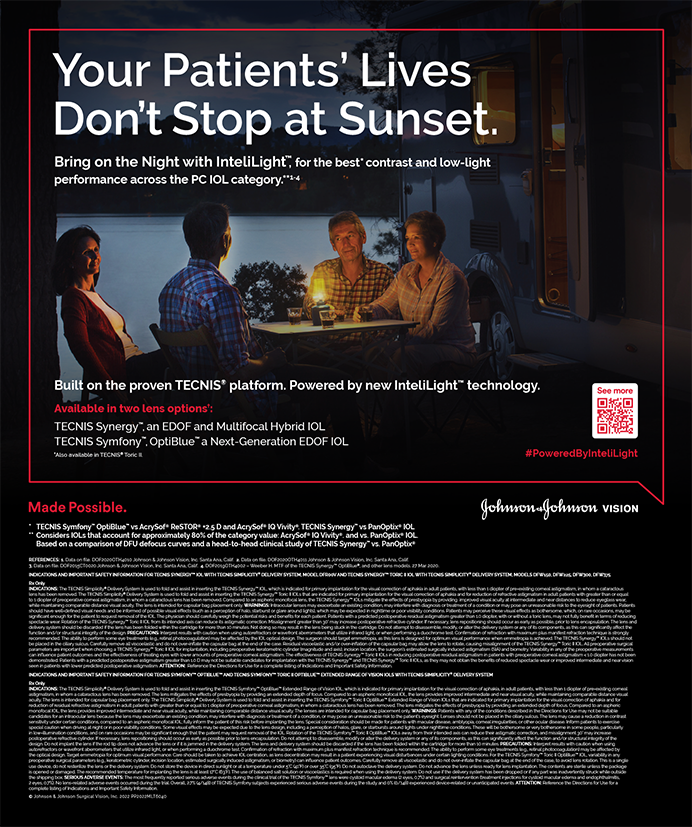Up Front | Feb 2006
Letters
The following reader/author exchange refers to two articles, titled “Keratoconus and Forme Fruste Keratoconus” by John F. Doane, MD, FACS, and “Lamellar Keratorefractive Surgery” by Lee T. Nordan, MD, that appeared in our October 2005 issue.
Dr. Doane,
First, let me thank you for your article on the subject of keratoconus and forme fruste keratoconus. The point that history and examination are essential components to topography cannot be emphasized too strongly. As an aside, I noted that Dr. Nordan wrote without qualification that eyes with inferior steepening are already weakened and not appropriate for lamellar refractive surgery.
My question concerns the specifics of inferior-superior discrepancy. Is there an established point of reference for these measurements? Do topographic units specifically measure and record these values at these reference sites?
Apparently, Rabinowitz1 suggested 0.4mm above and 3.0mm below fixation, but I do not know if these are generally accepted. I noticed that your illustrations for the article use a Humphrey topographer (Carl Zeiss Meditec Inc., Dublin, CA), which I have, so please feel free to speak to this particular unit as to how to get the best measurements.
Kevin Denny, MD
San Francisco
1. Rabinowitz YS. Videokeratographic indices to aid in screening for keratoconus. J Refract Surg. 1995;11:371379.
Dr. Denny,
As I mentioned in my article, many causes of falsely positive inferior steepening can masquerade as forme fruste keratoconus or forme fruste pellucid marginal degeneration. Dr. Nordan is a highly observant clinician. I asked him to provide a more explicit answer to your query. He stated, “If a cornea has even very mild irregular astigmatism, it is already weakened. This would be mild keratoconus, not forme fruste keratoconus. If a cornea is asymmetrically steeper inferior to the visual axis or near the limbus, if the peripheral cornea is as thin as the central cornea, or if the central cornea is less than 505µm, then the chances that the cornea is weaker than normal (forme fruste keratoconus) are greatly increased, and the chances of ectasia after LASIK are far higher. My point is that you cannot tell which of these corneas will become ectatic and which will not, so the risk of performing LASIK is not worth it. Of course, not every one of these corneas will become ectatic, but, because many if not most will, I do not think we can justify LASIK when PRK may be performed with a minimal chance of ectasia.”
In clinical practice, I believe the point of reference is generally accepted to be the 3- to 5-mm optical zone along the superior vertical orientation versus along the inferior vertical orientation. Sometimes, it is the 90º versus the 270º meridian, but, in other cases, it can be 30º on either side of vertical (ie, 110º vs 290º). Sometimes, it is nonorthogonal, which is a “brighter red flag” and a cause for concern. I am not aware of any topographers that specifically measure and record the values at the reference sites.
I would surmise that the advice of Rabinowitz and McDonnell that you mention would work great if the apex were displaced (ie, the axial map's intense red spot is inferior to fixation, and the blue spot is just superior). Certainly, many cases of forme fruste keratoconus would be caught with this detection algorithm.
My practice pattern is to perform what I stated in the second paragraph of this response. I do have the Pathfinder Analysis Software (Carl Zeiss Meditec Inc.). I suggested to the company about 3 to 4 years ago that the software would be much better with higher sensitivity and specificity measures, but, to date, no changes have been made to my knowledge. For my preference, the false positives and false-negative reports are too high with the current software. In my experience, the recommendation I gave with the numerical map seems to be the most sensitive and specific. It has become my divining rod with this particular unit. I have some experience with other topographers, but I would not be able to provide equally knowledgeable information on them without looking at a significant number of cases; I do believe there is an art to deciphering the inkblots for each individual unit. I hope my response helps.
John F. Doane, MD, FACS
Kansas City, Missouri
The following letter refers to an article titled “The Introduction of IOLs” by Norman S. Jaffe, MD, that appeared in our October 2005 issue.
Dr. Byron,
The article by Dr. Jaffe and your introduction were a great trip down memory lane. I implanted my first IOL in 1975, remember Dennis Shepard's cross-country barnstorming in 1976 on behalf of IOLs, attended all of the original Century Plaza AIOIS meetings, had my picture taken with Robert Young after his FDA testimony, and am certainly reminded of the blood, sweat, tears, complications, and sleepless nights associated with the early IOL days.
I still do 10 or so cases a week and have come to take for granted how smooth and successful they usually are. It was good for me to review all of that early history again.
Robert Young, MD
Kona, Hawaii


